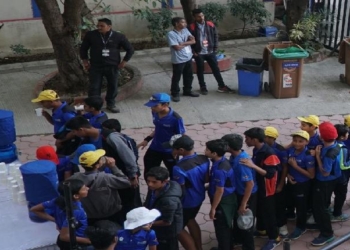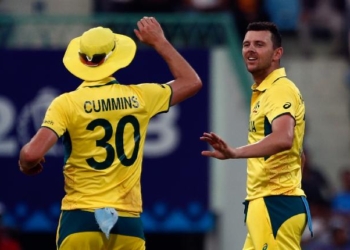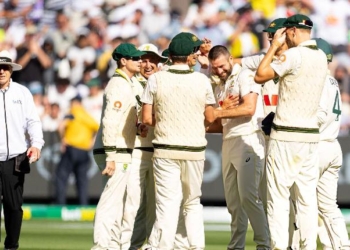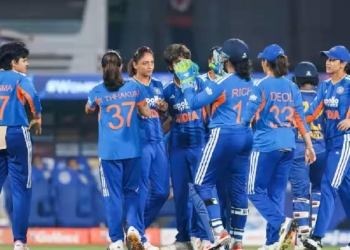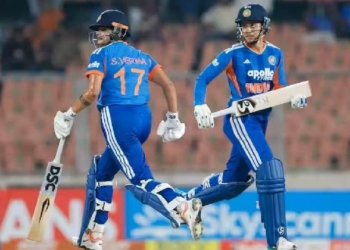Mumbai: The Wankhede Stadium in Mumbai on Wednesday has been a host to many memorable matches in the history of Men’s ODI World Cup, including the 2011 final where India ended the wait of lifting the trophy and achieved glory in front of home fans.
Come Wednesday, and Wankhede Stadium will be all decked in blue when India take on New Zealand in the first semifinal of the 2023 Men’s ODI World Cup. In this World Cup, the stadium has hosted four matches and it presents some pointers which can be the keys to success for both teams in the crucial knockout match.
The first step is to ideally win the toss. As per the statistics provided by Cricket-21.com, in the ongoing World Cup, the teams batting first have won three of the four games, with the one won batting second by Australia coming due to Glenn Maxwell’s astonishing 201 against Afghanistan.
Out of the four matches, captains have opted to bat first and bowl first on two occasions each in this World Cup. The average first innings score at this venue for the World Cups has been 357/6 whereas the average first innings winning score has been 379/7.
South Africa and India have made totals in excess of 350 in the first three matches of this venue’s World Cup games, and emerged victorious. There’s more to support the notion of batting first for anyone who wins the toss at Wankhede on Wednesday.
Batting first have performed well when compared to batting second teams as under lights, as the batters have found it difficult to score in overs 1-10 in this venue while chasing during the World Cup.
In the 1-10 overs phase in first innings, 209 runs have been made with run-rate being 5.2 and balls per boundary at 7.2. Plus, the average runs and wickets at 52.3 and 1.3 respectively. But in batting second in 1-10 overs phase, the numbers tell a different story.
With the new ball swinging and seaming more under the Wankhede Stadium lights, batters have been able to make only 168 runs, at a run-rate of 4.2 and balls per boundary at 10.5. Plus, the average runs and wickets stands at 42 and 4.3 respectively.
But if one is ready to stay at the crease for long, then they can garner big runs in the last ten overs of power-play, as far as the first innings is concerned. The last ten overs scores of the first innings read as: 143/2, 144/2, 93/4 and 96/2, thus showing teams can go big at the end via their big-hitting finishing skills.
In terms of bowling, fast-bowlers have been ruling the roost so far in the tournament at Wankhede. The fast-bowlers have picked 47 wickets, averaging 29 at an economy rate of 6.6 and strike-rate of 26.4. On the other hand, the spinners have only managed to take 11 scalps while averaging 70.1 at an economy rate of 6 and strike-rate of 70.2.
Moreover, bowlers have found good success in terms of average and economy rate in second innings when compared to first innings in Wankhede in this World Cup. In the overs 1-10 of second innings, fast-bowlers have average and economy rate of 9.2 and 4.1 respectively, while corresponding figures for spinners read as 0 and 5.5 respectively.
Compare this to 1-10 overs in first innings – for pacers, it becomes 45.8 and 5.6 in average and economy rate respectively, while for spinners, it reads as 26 and 3.6 respectively. For overs 11-40 in second innings, pacers have average and economy rate of 23.3 and 6.1 respectively, while for spinners, it reads as 43.4 and 5.5 respectively.
In terms of 111-40 overs in first innings, pacers average 59.5 and have an economy rate of 6.6, while for spinners, it stands at average and economy rate of 96.8 and 5.9 respectively. When it comes to overs 41-50 in the second innings, pacers have average and economy rate of 39.5 and 8.2 respectively.
The same figures for spinners in that over period reads as 0 and 8.1 respectively. On the other hand, pacers average 40.8 and have economy rate of 12.2 in first innings of overs 41-50, while the same figures for spinners read as 109 and 10.9 respectively.
Coming to the match between India and New Zealand, as per the facts provided by Sportradar, the battle between India’s bowlers and New Zealand’s batters in middle overs between 11-40 will be a vital clash.
In the tournament, New Zealand have been extremely good with the bat in this phase, making 1563 runs, averaging 55.8 at a run-rate of 6.4. On the other hand, India have been the best-performing bowling team in the same phase, taking 45 scalps at an average of 22.9, which translates to five wickets per game on an average.
Talismanic India batter Virat Kohli, currently the leading scorer of the tournament with 594 runs in nine innings at an average of 99, has been equally impressive against both pace (346 runs at an average of 69.2) and spin (248 runs at an average of 248).
Kohli has relished playing against New Zealand at home, with his figures reading 1005 runs in 17 innings at average of 71.8, including five fifties and four centuries. He had also hit a match-winning 95 in the clash against New Zealand at Dharamshala.
Fast-bowler Mohammad Shami has lit up the World Cup by taking 16 wickets in just six innings at an incredible average of 9.6. He has been able to get the better of batters in powerplays, taking six scalps at an average of 6.3 and strike-rate of 8.
Shami took a sensational 5/54 against New Zealand in the group stage game at Dharamshala, which was also his first match of this competition. He also boasts of incredible numbers against New Zealand in ODI cricket taking 30 wickets in 13 innings at an average of 21.9.
With both India and New Zealand possessing of in-form and highly experienced players in their ranks, how the toss, who would bat first, how the teams fare in terms of first ten overs, middle-overs and fast-bowlers will prove to be decisive in this highly-anticipated clash at the Wankhede, where all roads in Mumbai will be leading to on Wednesday.
(IANS)





